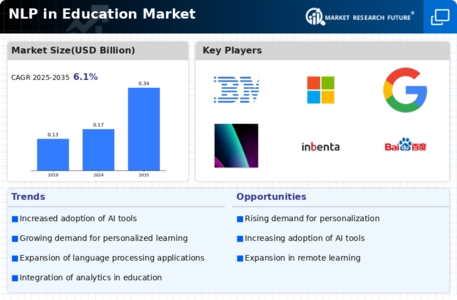Market Analysis
In-depth Analysis of NLP in Education Market Industry Landscape
The Natural Language Processing (NLP) dynamics within the education arena are undergoing profound transformational changes. This means that machines should be designed to understand human language like humans do.
One major driver behind the increasing demand for personalized learning experiences is personalization as well as adaptability. The emergence of online education platforms and digital learning has led to an increased need for intelligent systems, which can analyze student data, understand their learning needs and give personalized feedbacks and recommendations. NLP technologies play a significant role in extracting meaningful insights from large volumes of educational content and students’ data; hence making it possible to develop personalized learning solutions.
Another factor affecting the market dynamics of NLP in education is the demand for efficient language assessments that are also accurate. Proficiency in language use is a vital element in education; however, traditional methods of assessment have proved inadequate. Thus, teachers can now assess their learners using the NLP based tools capable of analyzing students’ written or oral answers for correctness while suggesting the possible errors made by these individuals. They also make these procedures less subjective allowing instructors do not waste much time on grading papers; instead they focus on lesson planning.
NLP in education market’s dynamics have been shaped by technological advancements too. Consequently, with the advent growth in machine leanings as well as deep machine learning algorithms also referred to as deep learning algorithms there has been more sophisticated natural language processing systems that simulate human-like conversations. The latter innovation offers opportunities for interactive conversational teaching where learners interact naturally with virtual tutors or chatbots operating with human language software i.e., natural language processing. This helps improve student engagement through immersive learning experiences that offer individualized assistance leading to improved academic performance.
Moreover, the growing popularity of NLP technologies in education can be attributed to the need for effective content production and management. The developers of educational materials confront numerous problems when creating or organizing teaching resources that are available and attractive to students. Content creation is one of the many things that natural language processing tools can handle: summarize, extract main ideas, and put teaching materials together systematically. Not only does this save time and energy, but it also makes learning resources more accessible and comprehensible to students.
Additionally, there are challenges facing market dynamics in NLP for education. One major issue is ethical usage of NLP technologies like those related to privacy as well as biasedness. Since these systems depend on student data on a large scale, there should be strong privacy policies and security protocols to guarantee protection of sensitive information. Furthermore; it is necessary that those developing NLP algorithms ensure they do not have defects that may uphold social disparities or discriminate against specific sets of students.
Another obstacle is how NLP technologies can work with existing education systems and practices. Training and professional development are some requirements that educators and institutions need to invest in so as to use NLP tools effectively within their teaching practices. There might also be resistance or doubt from teachers or decision-makers who have no knowledge about these technologies or feel hesitant about embracing them.



















Leave a Comment